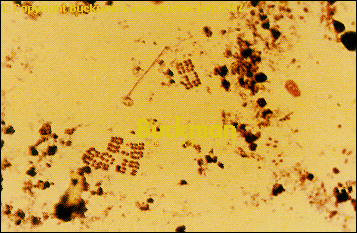|
Among the general population of people on our planet, bacteria are thought of as disease causing organisms, such as those that cause cholera, tuberculosis, gonorrhea, and more common infections diagnosed daily by physicians in people with respiratory, digestive, or other ailments. The harmful bacterial population on earth represents a relatively tiny fraction of the population of bacteria as a whole. They can be found everywhere, from the tops of the highest mountains, to the deepest depths of the oceans, to the soils and rocks of the earth’s crust, and in all living organisms. The have a unique ability to survive without sustainable food sources by means of their ability to go dormant for extended periods of time.
Bacteria play an essential role in life and the global ecosystem. The oldest fossils known are those from bacteria, some over 3.5 billion years old. The bio-cycles of nutrient conversions would not occur without their ceaseless efforts. Organic carbons from dead and rotting organisms become unusable by other living things unless it is decomposed and the nutrients released back into the environment. Without the bio-cycle effect of the bacteria, no photosynthesis would occur in plants and all plant life processes would cease. There would subsequently be no available food for the “food chain” of all life on earth. Carbons would be tied-up in unusable forms, and oxygen supplies would eventually disappear, being attached to the carbons in the form of CO2.
Most bacteria are classified into three groups, based upon their response to oxygen. Aerobic forms of bacteria thrive in oxygen environments. Oxygen is required for their existence. Anaerobic forms of bacteria are the opposite, in that they have no tolerance to oxygen. Facultative anaerobes have preference to oxygen, but can survive without it. Further classification of bacteria can be made in terms of their sources of energy. Heterotrophs obtain energy from complex organic compounds found in the environment in the form of decaying organic matter, and in processes of respiration or fermentation. Autotrophs survive by fixation of carbon dioxide as Oxygen is required for their existence. Anaerobic forms of bacteria are the opposite, in that they have no tolerance to oxygen. Facultative anaerobes have preference to oxygen, but can survive without it. Further classification of bacteria can be made in terms of their sources of energy. Heterotrophs obtain energy from complex organic compounds found in the environment in the form of decaying organic matter, and in processes of respiration or fermentation. Autotrophs survive by fixation of carbon dioxide as
|
Sulfur Bacteria Buckman Laboratories 1997
|
their food source. This process is further fueled by light energy, or by oxidation of Nitrogens, Sulfurs, or other elements.
Plants rely upon nitrogen as a primary nutrient for their growth. They cannot take in nitrogen from the air, so sources within the soil are critical to their existence. The cycling of nitrogen is a key role of bacteria in the soil. The process of nitrogen fixation is where bacteria convert gaseous nitrogen into nitrate and nitrite nitrogen as part of their metabolism. The resulting product is released by the bacteria into the soil environment for absorption by plants.
Bacteria are single cell organisms that contain DNA, ribosomes, plasmids, and a cell wall membrane. Plasmids are small loops of DNA that can be transmitted through the cell membrane into other cells through the course of sex, or by viruses. This ability makes bacteria extremely adaptable in that beneficial genes may be spread throughout bacterial populations.
In the soil micro-environment, bacteria work in unison with other microbial life forms including Algae, Fungi, Actinomycetes, and Protozoa, all of which carry out specific roles in the soil system, and are therefore conducive to plant growth. All of these are also reliant upon a proper balance of enzymes, both aerobic and an anaerobic. Any imbalance in the ratio of bacterial populations and/or that of the other microbes in relationship to each other, will have a direct affect on the health of the soil. In order to grow crops, or other plant life in imbalanced soils, inoculation of bacteria and enzyme systems, as well as prepared nutrients, is needed.
|



 Oxygen is required for their existence. Anaerobic forms of bacteria are the opposite, in that they have no tolerance to oxygen. Facultative anaerobes have preference to oxygen, but can survive without it. Further classification of bacteria can be made in terms of their sources of energy. Heterotrophs obtain energy from complex organic compounds found in the environment in the form of decaying organic matter, and in processes of respiration or fermentation. Autotrophs survive by fixation of carbon dioxide as
Oxygen is required for their existence. Anaerobic forms of bacteria are the opposite, in that they have no tolerance to oxygen. Facultative anaerobes have preference to oxygen, but can survive without it. Further classification of bacteria can be made in terms of their sources of energy. Heterotrophs obtain energy from complex organic compounds found in the environment in the form of decaying organic matter, and in processes of respiration or fermentation. Autotrophs survive by fixation of carbon dioxide as